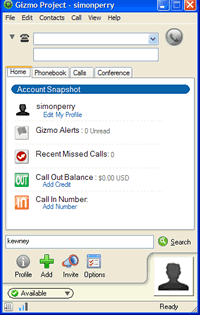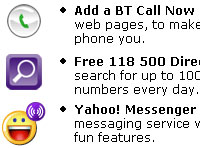 It’s not surprising that when an entrepreneur sees something as successful as Skype has been, (you can’t see over 127m downloads in any other way), that the word opportunity is writ large in their eyes. This is especially when that person likes disrupting legacy business models, such as the phone system.
It’s not surprising that when an entrepreneur sees something as successful as Skype has been, (you can’t see over 127m downloads in any other way), that the word opportunity is writ large in their eyes. This is especially when that person likes disrupting legacy business models, such as the phone system.
Enter Michael Robertson, he of mp3.com fame.
After selling mp3.com for a considerable amount of money, Mr Robertson went on to create Lindows. A Linux-based desktop operating system that aimed to take on Microsoft and their Windows product head on. After some huffing and puffing from Microsoft Lindows changed its name to the less controversial Linspire.
During the time of building up Linspire, I was surprised to see Robertson launched SIPPhone.com – his first pop at a VoIP business. When I first saw this it looked like a distraction from his OS business, almost like he saw the great opportunity of VoIP coming and couldn’t resist jumping on top of it.
Well things have move on now, and after 6 months software development, Robinson is publicly showing his Skype-killer, Gizmo Project.
 The big differentiator between Gizmo Project (a temporary name – they’re asking for suggestions) and Skype is Gizmo uses the open standard of SIP (Session Initiation Protocol, for those who really want to know), as opposed to the proprietary method Skype uses. This goes after Skype in the only way it can.
The big differentiator between Gizmo Project (a temporary name – they’re asking for suggestions) and Skype is Gizmo uses the open standard of SIP (Session Initiation Protocol, for those who really want to know), as opposed to the proprietary method Skype uses. This goes after Skype in the only way it can.
Many of the early users of Skype were hardcore Linux/Open source fans. Although using Skype was free, it still stuck in their throats a little that they were talking over proprietary protocols.
Skype doesn’t allow connections to other VoIP service, and as they control all of the inside processing, if they don’t want it to happen, it won’t.
Robertson claims that as Gizmo is SIP-based, it will interconnect to any other phone system.
Using Gizmo Once the software is installed, anyone familiar with Skype will not have a problem quickly adapting to use Gizmo. It runs on Linux, Macintosh and Windows. It appears to have all of Skype’s functions plus quite a few extras.
Useful additional features include a call quality meter, located at the bottom left of the app.
Gee whiz factor is provided by features like the World map that can be summoned up, showing you how far you are calling – good for gloating that you’re not paying a penny extra for calling that distance.
Despite the product being in beta, it’s currently on version 0.8, Gizmo haven’t been slow in holding back on the in and outbound call features – the ones that generate the income. It was surprising to see that the pricing of Gizmo In is more expensive than SkypeIn, with the $30 buying just 6 months of service compared with Skypes – I thought new entrants to a market were supposed to be more competitive not half the value.
 Skype has done well in encouraging other companies to build extra software and importantly, hardware including phone handsets (Siemens M34; Cyberphone K). This has been enabled by them publishing the API (Application Program Interface). As to whether/if Gizmo will have an API as Skype does, is as yet unclear.
Skype has done well in encouraging other companies to build extra software and importantly, hardware including phone handsets (Siemens M34; Cyberphone K). This has been enabled by them publishing the API (Application Program Interface). As to whether/if Gizmo will have an API as Skype does, is as yet unclear.
Trying to unseat Skype is one hell of a tough battle; it’s seriously entrenched in the tech world, and is making pretty strong moves in to the general market.
The fact that it uses open protocols is a big advantage, if that kind of thing is important to you. For the rest of the market what’s important is that they’re able to speak to their friends on the service. As things stand today, that is probably Skype.
Expect a rash of these applications.
Gizmo Project
 As part of Motorola’s strategy to tempt home and business with new services, the company has announced that it will add Yahoo! Web services to their Linux-based mobile devices.
As part of Motorola’s strategy to tempt home and business with new services, the company has announced that it will add Yahoo! Web services to their Linux-based mobile devices. Ron Garriques, president of Motorola’s mobile device business, said: “By optimising these products for our leading Linux and Java software platform, we’re making it just that much easier for operators to maximize revenue while delivering the most innovative consumer experiences.”
Ron Garriques, president of Motorola’s mobile device business, said: “By optimising these products for our leading Linux and Java software platform, we’re making it just that much easier for operators to maximize revenue while delivering the most innovative consumer experiences.” Elsewhere, the company have also announced that Vonage will offer the new Motorola VT2442 voice over Internet Protocol (VoIP) gateway to its Internet telephony customers.
Elsewhere, the company have also announced that Vonage will offer the new Motorola VT2442 voice over Internet Protocol (VoIP) gateway to its Internet telephony customers. The North American voice over IP (VoIP) market is about to go completely bananas, with phenomenal growth predicted for the next six years, according to a report by Frost & Sulllivan.
The North American voice over IP (VoIP) market is about to go completely bananas, with phenomenal growth predicted for the next six years, according to a report by Frost & Sulllivan. The VoIP’s operator’s joy could be the incumbent local exchange carriers (ILECs) misery, as Internet telephony represents a direct threat their market share and revenue.
The VoIP’s operator’s joy could be the incumbent local exchange carriers (ILECs) misery, as Internet telephony represents a direct threat their market share and revenue. The report concludes that it’s the quality of service and the VoIP feature set that’s attracting punters to the service rather than a desire to get in with the hi-tech crowd.
The report concludes that it’s the quality of service and the VoIP feature set that’s attracting punters to the service rather than a desire to get in with the hi-tech crowd. Skype has teamed up with The Cloud – Europe’s leading Wi-Fi network provider – to offer low cost Wi-Fi access and Internet voice calls at 6,000 of The Cloud’s hotspots in the UK and Sweden.
Skype has teamed up with The Cloud – Europe’s leading Wi-Fi network provider – to offer low cost Wi-Fi access and Internet voice calls at 6,000 of The Cloud’s hotspots in the UK and Sweden. Skype users ambling into a Cloud hotspot will be connected to the service as soon as they flip out their Wi-Fi enabled device.
Skype users ambling into a Cloud hotspot will be connected to the service as soon as they flip out their Wi-Fi enabled device. “Skype is bringing affordable Wi-Fi and voice calls to millions of users, enabling them to talk, IM and surf conveniently and cost-effectively from thousands of great locations. Our users in the UK and Sweden will benefit from The Cloud’s extensive network coverage in places where people really want to use it.”
“Skype is bringing affordable Wi-Fi and voice calls to millions of users, enabling them to talk, IM and surf conveniently and cost-effectively from thousands of great locations. Our users in the UK and Sweden will benefit from The Cloud’s extensive network coverage in places where people really want to use it.” We had a report from a reader today that he’d been … ehm, carrying out tests on his content filtering service. This entailed going to sites with photos of naked bodies – purely to test that the content filter blocked his access to them you understand. One of first sites he went to was the well known UK tabloid, The Sun.
We had a report from a reader today that he’d been … ehm, carrying out tests on his content filtering service. This entailed going to sites with photos of naked bodies – purely to test that the content filter blocked his access to them you understand. One of first sites he went to was the well known UK tabloid, The Sun. The piece in the Gizmo section of the site and paper features BT’s new model to promote BT Communicator, Michelle Marsh.
The piece in the Gizmo section of the site and paper features BT’s new model to promote BT Communicator, Michelle Marsh. Boingo Wireless and Skype have fluttered eyelids at each other, gone for a quiet snog and, ruddy faced, jointly announced Skype Zones, a partnership that offers global Wi-Fi access to Skype customers at (ahem) “revolutionary” prices.
Boingo Wireless and Skype have fluttered eyelids at each other, gone for a quiet snog and, ruddy faced, jointly announced Skype Zones, a partnership that offers global Wi-Fi access to Skype customers at (ahem) “revolutionary” prices. Fluffing up the big pink cushions of corporate love, Niklas Zennstrom, Skype CEO purred passionately about his new partner: “Boingo is a world-class company that offers Skype users unprecedented global communications mobility and accessibility, at an aggressive, market disrupting price.”
Fluffing up the big pink cushions of corporate love, Niklas Zennstrom, Skype CEO purred passionately about his new partner: “Boingo is a world-class company that offers Skype users unprecedented global communications mobility and accessibility, at an aggressive, market disrupting price.” Monthly access to Skype Zones is $7.95 per month for unlimited Skype access or $2.95 (~€2.42~£1.66) for a 2-hour connection.
Monthly access to Skype Zones is $7.95 per month for unlimited Skype access or $2.95 (~€2.42~£1.66) for a 2-hour connection. Their glorious football team many not be first at anything much these days, but BT have announced that Cardiff and the surrounding area will lead the UK with the implementation of their 21st Century Network (21CN).
Their glorious football team many not be first at anything much these days, but BT have announced that Cardiff and the surrounding area will lead the UK with the implementation of their 21st Century Network (21CN). BT is expected to begin migrating around 350,000 customer lines in the area during the second half of 2006, with the 21CN programme requiring the replacement of equipment in more than 50 local exchanges along with the implementation of new IT systems to make the technology do its stuff.
BT is expected to begin migrating around 350,000 customer lines in the area during the second half of 2006, with the 21CN programme requiring the replacement of equipment in more than 50 local exchanges along with the implementation of new IT systems to make the technology do its stuff. It’s not surprising that when an entrepreneur sees something as successful as Skype has been, (you can’t see over 127m downloads in any other way), that the word opportunity is writ large in their eyes. This is especially when that person likes disrupting legacy business models, such as the phone system.
It’s not surprising that when an entrepreneur sees something as successful as Skype has been, (you can’t see over 127m downloads in any other way), that the word opportunity is writ large in their eyes. This is especially when that person likes disrupting legacy business models, such as the phone system. The big differentiator between Gizmo Project (a temporary name – they’re asking for suggestions) and Skype is Gizmo uses the open standard of SIP (Session Initiation Protocol, for those who really want to know), as opposed to the proprietary method Skype uses. This goes after Skype in the only way it can.
The big differentiator between Gizmo Project (a temporary name – they’re asking for suggestions) and Skype is Gizmo uses the open standard of SIP (Session Initiation Protocol, for those who really want to know), as opposed to the proprietary method Skype uses. This goes after Skype in the only way it can. Skype has done well in encouraging other companies to build extra software and importantly, hardware including phone handsets (
Skype has done well in encouraging other companies to build extra software and importantly, hardware including phone handsets ( Delivering a king size slipper to the ample bottom of BT, the Advertising Standards Authority (ASA) has ruled that BT’s PC-based internet telephony service, BT Communicator, does not make “free” calls.
Delivering a king size slipper to the ample bottom of BT, the Advertising Standards Authority (ASA) has ruled that BT’s PC-based internet telephony service, BT Communicator, does not make “free” calls. The Kentish complainant pointed out that by using the VoIP service he’d rapidly burn up the 1 gig a month usage limit that BT slaps on its Broadband Basic packages – and once he exceeded that limit, he’d have to start forking out for additional time online.
The Kentish complainant pointed out that by using the VoIP service he’d rapidly burn up the 1 gig a month usage limit that BT slaps on its Broadband Basic packages – and once he exceeded that limit, he’d have to start forking out for additional time online. Smarting from a derriere rouge par excellence, BT was told “not to describe calls that depleted a consumer’s usage allowance as ‘free’ and to state prominently in advertisements for BT Communicator that making telephone calls depleted a consumer’s broadband usage allowance”.
Smarting from a derriere rouge par excellence, BT was told “not to describe calls that depleted a consumer’s usage allowance as ‘free’ and to state prominently in advertisements for BT Communicator that making telephone calls depleted a consumer’s broadband usage allowance”.
 The spokesman added that customer’s email services will be uninterrupted, with users still contactable whatever their domain name.
The spokesman added that customer’s email services will be uninterrupted, with users still contactable whatever their domain name. Last weekend there was a report that France Telecom (FT) were rumored to be buying Cable and Wireless (C&W) for GBP 4bn. FT has of course denied it.
Last weekend there was a report that France Telecom (FT) were rumored to be buying Cable and Wireless (C&W) for GBP 4bn. FT has of course denied it. One area where they have invested in and have made real progress is Local Loop Unbundling (LLU) with their purchase of Bulldog (for GBP 18m). Bulldog have now unbundled about 400 exchanges and have plans to unbundle another 400 by the end of the year.
One area where they have invested in and have made real progress is Local Loop Unbundling (LLU) with their purchase of Bulldog (for GBP 18m). Bulldog have now unbundled about 400 exchanges and have plans to unbundle another 400 by the end of the year. Wanadoo (the ISP arm of FT) has stated they are going to invest EU 300m in unbundling exchanges (in the first year) and rumour has it there’s a total of EU 1bn over 3 years for LLU. So FT could buy C&W just for the LLU aspects, but really does seem excessive. C&W bought Bulldog for GBP 18m and they’ve invested at least 10’s of million into them. So 4bn is a HUGE premium to pay for a ready made network and 10’s of thousands of customers. Wanadoo already have considerably more broadband customers than Bulldog.
Wanadoo (the ISP arm of FT) has stated they are going to invest EU 300m in unbundling exchanges (in the first year) and rumour has it there’s a total of EU 1bn over 3 years for LLU. So FT could buy C&W just for the LLU aspects, but really does seem excessive. C&W bought Bulldog for GBP 18m and they’ve invested at least 10’s of million into them. So 4bn is a HUGE premium to pay for a ready made network and 10’s of thousands of customers. Wanadoo already have considerably more broadband customers than Bulldog.